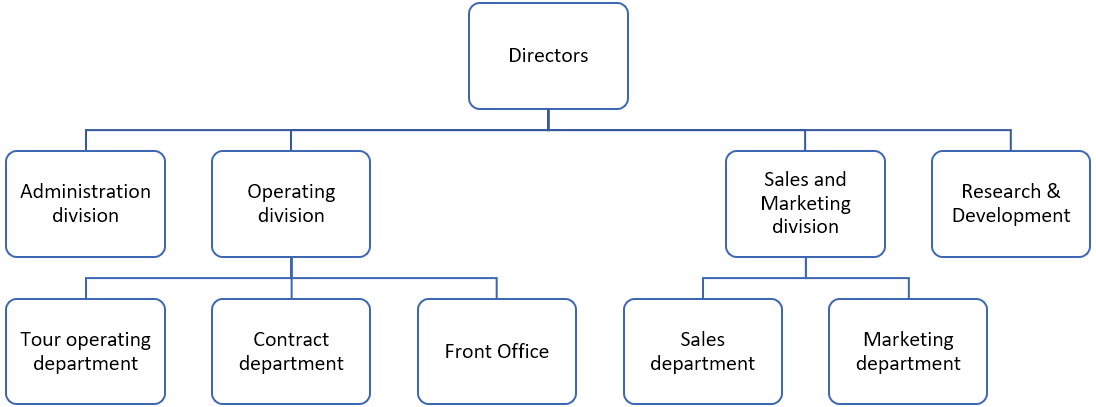The typical organisational structure of travel companies should be divided into four divisions, including the administration division, the sales and marketing division, the operational division, and the research and development division.

Schematic representation of the typical organisational structure of medium/large travel and tourism agencies
- The Directors or Management area: is where the executives and top-level managers coordinate and control all the business activities. In addition, all critical business decisions, including strategic, financial, operational, policy, etc., are made within this area before being employed by the whole company.
- The Administration division: This division could contain several departments, including administration, accounting, financial management and human resources. For many small/medium-sized companies, these functions could be carried out by a few staff. The employees might be required to take responsibility for different positions simultaneously. For example, the accountant of the company might also be the one that handles other administrative activities at the office.
- The Operational division: This division can be considered the heart of the travel companies, where all the activities are related to delivering tourism products. Within this division are an operating tour department, a contract department and an agency department.
- The tour operating department or the project department is responsible for the actual products and services to be carried out. The functions of this department include trip planning, tour operating, handling all necessary bookings and other preparation for the products/services to be ready to deliver to customers.
- The contract department: This department is responsible for managing and maintaining the relationship with business partners and services providers such as hotels, transportation partners, freelancers, etc., where the trips and stays occur.
- The agency department (or front office department): is where the intermediation activities are carried out. This department exists in the business that operates as travel agencies to connect the need of end-consumers with the service providers such as airlines, hotels, other transportation companies etc.
- The Sales and Marketing division: In some companies, this division could be divided into two separate divisions for better distinguishment. All of the actions intended to advertise and market the goods and services offered by the agency, as well as those intended to research and keep an eye on the competition and the tourist industry, are carried out in the commercial and marketing area. Within this area, it is essential to distinguish the function of sales and marketing.
- The sales department: is responsible for selling products and services to customers. This department’s main tasks are managing relationships with potential and existing clients and providing solutions for clients that eventually lead to a sale. In some companies, the job of this department does not stop when the customers have booked the trips. The salespeople might be required to continue providing customer services by following up with customers after sales.
- The marketing department: is responsible for informing and attracting people to the business’s brand, products and services. Marketers should use market research and analysis to understand the interest of potential customers. After that, the marketing campaign or strategy can be developed using appropriate techniques
- It is worth mentioning that it has become more common for travel companies to hire specialised individuals in communication and the web, such as Web Developers, Webmasters, Web analysts, Graphic designers, etc. Due to the growing use of the Internet and the impact of the COVID-19 pandemic, the promotion and sales of tourism products and services have experienced a considerable switch to digital content. Many businesses have paid more attention to the IT sector to approach and enhance communication with consumers. These tasks can also be outsourced to independent contractors or professionals employed by specialised businesses.
- The Research and Development division (R&D): is responsible for the creation of new products/services or the enhancement/ improvement of existing products/ services to maintain the competitive advantages of the company. For some companies, this division could be combined with the Operational division or partly combined with the Marketing area. Throughout the face-to-face interviews, many companies have mentioned the importance of market data analysis and content creation that will lead to product developments. The tourism industry is very competitive with many competitors and the fast-moving pace of consumers’ demands. Therefore, to develop more attractive products and services, travel companies need to understand the market movements, the change in the social environment, the need of consumers.



